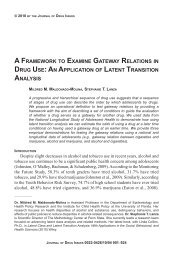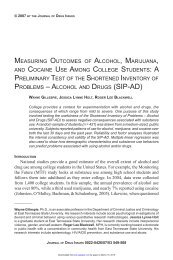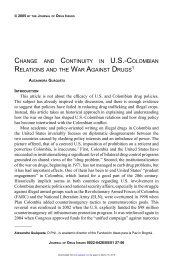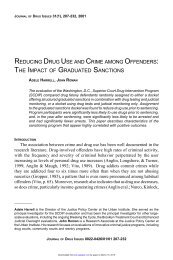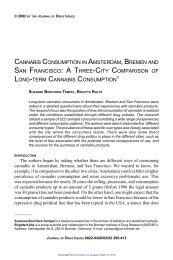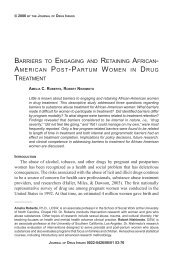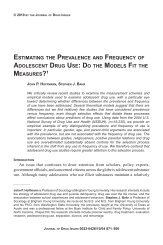a brief history of cannabis policies in spain - Journal of Drug Issues
a brief history of cannabis policies in spain - Journal of Drug Issues
a brief history of cannabis policies in spain - Journal of Drug Issues
You also want an ePaper? Increase the reach of your titles
YUMPU automatically turns print PDFs into web optimized ePapers that Google loves.
GAMELLA, JIMÉNEZ RODRIGO<br />
& Rodriguez-Artalejo, 2000; Gamella & Álvarez Roldán, 1999; Díaz, Barruti, &<br />
Doncel, 1992).<br />
In this paper we will review the current status <strong>of</strong> drug laws and the major public<br />
<strong>policies</strong> that have been implemented <strong>in</strong> Spa<strong>in</strong> over the last 25 years; their<br />
demographic, political, and economic contexts; and their apparent consequences.<br />
We will follow a chronological approach that outl<strong>in</strong>es every major change that<br />
occurred dur<strong>in</strong>g that period while try<strong>in</strong>g to provide some sociopolitical background.<br />
We have divided the period under study <strong>in</strong>to four major phases. Each phase addresses<br />
a major political change or shift <strong>in</strong> the social response to drug-related problems.<br />
In this account, we will apply to <strong>cannabis</strong> <strong>policies</strong> the conceptual dist<strong>in</strong>ctions<br />
<strong>in</strong>troduced by MacCoun and Reuter <strong>in</strong> their recent revision <strong>of</strong> alternative drug<br />
<strong>policies</strong> (2001), especially their tripartite division between punitive, depenaliz<strong>in</strong>g,<br />
and legaliz<strong>in</strong>g regimes, and the associated processes <strong>of</strong> promotion and<br />
commercialization. One essential question that concerns the Spanish case is the<br />
relationship that exists between legal changes, their implementation, and periodic<br />
oscillations <strong>in</strong> consumption rates.<br />
FIRST PHASE 1968-1977: JOINTS AS A BADGE OF CULTURAL AND POLITICAL REBELLION<br />
As <strong>in</strong> other Western countries, illegal drug use <strong>in</strong> Spa<strong>in</strong> appeared as a press<strong>in</strong>g<br />
issue with the expansion <strong>of</strong> the youth counterculture <strong>of</strong> the late 1960s and early<br />
1970s. At this time, new patterns <strong>of</strong> illicit drug consumption ma<strong>in</strong>ly concerned<br />
<strong>cannabis</strong>, and, to a lesser extent, halluc<strong>in</strong>ogens such as LSD, and drugs obta<strong>in</strong>ed <strong>in</strong><br />
pharmacies (for example, barbiturates, benzodiazep<strong>in</strong>es, and amphetam<strong>in</strong>es). Most<br />
<strong>of</strong> these new forms <strong>of</strong> drug experimentation were imported fads. Spa<strong>in</strong> was already<br />
a tourist dest<strong>in</strong>ation for millions <strong>of</strong> foreigners, and Ibiza and other Mediterranean<br />
enclaves figured prom<strong>in</strong>ently <strong>in</strong> hippies’ and beachcombers’ usual routes.<br />
But <strong>in</strong> Spa<strong>in</strong> there was an autochthonous tradition <strong>of</strong> <strong>cannabis</strong> consumption,<br />
derived from over a century <strong>of</strong> colonial adventures <strong>in</strong> Northern Africa. In the 1940s<br />
and 1950s, Moroccan marijuana was smoked <strong>in</strong> many cities, especially <strong>in</strong> Madrid,<br />
Barcelona, and other locations that ma<strong>in</strong>ta<strong>in</strong>ed stronger l<strong>in</strong>ks with the Spanish<br />
Protectorate, such as Algeciras, Malaga, Cadiz, Valencia, and Las Palmas (González<br />
Duro, 1978, p. 71). This practice was largely ignored by police and courts, which<br />
saw it as befitt<strong>in</strong>g “degenerated, undesirable, marg<strong>in</strong>al people… such as exlegionnaires,<br />
pimps, cheap prostitutes, drunkards, and petty thieves….” Smokers<br />
were known as “grifotas,” a term derived from “grifa,” which is low grade Moroccan<br />
marijuana (González Duro, p. 73). The ma<strong>in</strong> traders <strong>in</strong> this commodity were soldiers<br />
who had served <strong>in</strong> Africa. “It was rare the soldier who had not tried grifa or kiffi at<br />
least occasionally after be<strong>in</strong>g stationed <strong>in</strong> the Spanish Protectorate <strong>in</strong> Morocco ”<br />
(González Duro, p. 72).<br />
626 JOURNAL OF DRUG ISSUES<br />
Downloaded from jod.sagepub.com by guest on March 15, 2015








